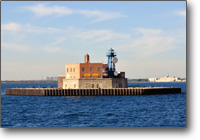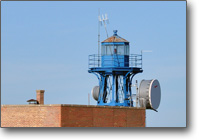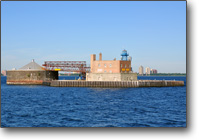Historical Information
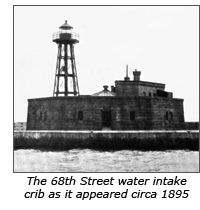 The 68th Street Crib was built in 1892, and supplied
two tunnels. The first tunnel with a diameter of 20 feet supplied the
Jardine Water purification plant which was at one time the largest
purification plant in the world. A second smaller tunnel of 10 foot
diameter supplied the South water purification plant. To increase
inflow to the city, a second crib, known appropriately as the
“Intermediate Crib” was established on the line from the 68th Street
tunnel system in 1909. The 68th Street Crib was built in 1892, and supplied
two tunnels. The first tunnel with a diameter of 20 feet supplied the
Jardine Water purification plant which was at one time the largest
purification plant in the world. A second smaller tunnel of 10 foot
diameter supplied the South water purification plant. To increase
inflow to the city, a second crib, known appropriately as the
“Intermediate Crib” was established on the line from the 68th Street
tunnel system in 1909.
 While building this crib on January 20 of that year, 70 out of the 106
men working on the crib’s construction were killed in a devastating
fire which ravaged the structure. Unfortunately, with the weather being
particularly bad at the time of the fire, the supply tug which was
normally moored at the site throughout construction had been relocated
to the harbor, and thus there was no way to take any of the crewmembers
off. There was concern voiced that dynamite stored in the crib had
exploded, but a number of witnesses at the hearing testified that they
did not hear any explosion. This Intermediate Crib is no longer in
existence.
The 68th Street Cribs' light was exhibited from a silver gray lantern
atop a red cylindrical tower located at top dead center of the well
room roof. Equipped
with a 60 candlepower 300 mm acetylene burner within a 300mm optic, the
light sat at a focal plane of 60 feet with a range of visibility of 8
miles during clear weather. The fog signal was made on a bell with an
automated striking apparatus emitting a characteristic single stroke
every 12 seconds. While building this crib on January 20 of that year, 70 out of the 106
men working on the crib’s construction were killed in a devastating
fire which ravaged the structure. Unfortunately, with the weather being
particularly bad at the time of the fire, the supply tug which was
normally moored at the site throughout construction had been relocated
to the harbor, and thus there was no way to take any of the crewmembers
off. There was concern voiced that dynamite stored in the crib had
exploded, but a number of witnesses at the hearing testified that they
did not hear any explosion. This Intermediate Crib is no longer in
existence.
The 68th Street Cribs' light was exhibited from a silver gray lantern
atop a red cylindrical tower located at top dead center of the well
room roof. Equipped
with a 60 candlepower 300 mm acetylene burner within a 300mm optic, the
light sat at a focal plane of 60 feet with a range of visibility of 8
miles during clear weather. The fog signal was made on a bell with an
automated striking apparatus emitting a characteristic single stroke
every 12 seconds.
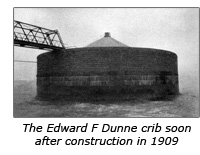 Chicago’s
population and industrial base continued to burgeon at the dawn of the
twentieth century, and it was clear that additional capacity needed to
be added to the existing supply. Rather than building a new intake crib
at a remote area which would require the addition of another crew of
keepers and living quarters, in 1909 the decision was made to erect a
second crib adjacent to the existing 68th Street crib, allowing the
existing keepers of the 68th Street crib to man both installations,
thereby significantly reducing operating costs on an ongoing basis.
Known as the Edward F Dunne crib, this new structure was named in honor
of Edward Fitzsimmons Dunne who was serving as Mayor when the plans for
the structure were approved, and who would subsequently go on to become
Governor of the state of Illinois. Chicago’s
population and industrial base continued to burgeon at the dawn of the
twentieth century, and it was clear that additional capacity needed to
be added to the existing supply. Rather than building a new intake crib
at a remote area which would require the addition of another crew of
keepers and living quarters, in 1909 the decision was made to erect a
second crib adjacent to the existing 68th Street crib, allowing the
existing keepers of the 68th Street crib to man both installations,
thereby significantly reducing operating costs on an ongoing basis.
Known as the Edward F Dunne crib, this new structure was named in honor
of Edward Fitzsimmons Dunne who was serving as Mayor when the plans for
the structure were approved, and who would subsequently go on to become
Governor of the state of Illinois.
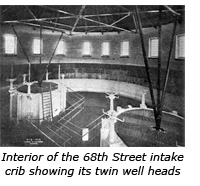 This
new crib stood 110 feet in diameter, and was located in 32 feet of
water. 25-foot thick stone walls housed a 60 foot diameter well which
in turn housed a pair of fourteen foot diameter intake pipes which
connected to a set of new tunnels connecting to a pair of new pumping
stations on shore. A steel foot bridge spanned the 45-foot distance
between the two cribs, allowing the keepers to pass easily between the
two structures. Because the well lighted 68th Street crib was located
so close, it was deemed unnecessary to install any aid to navigation
equipment – representing an additional minor cost saving. This
new crib stood 110 feet in diameter, and was located in 32 feet of
water. 25-foot thick stone walls housed a 60 foot diameter well which
in turn housed a pair of fourteen foot diameter intake pipes which
connected to a set of new tunnels connecting to a pair of new pumping
stations on shore. A steel foot bridge spanned the 45-foot distance
between the two cribs, allowing the keepers to pass easily between the
two structures. Because the well lighted 68th Street crib was located
so close, it was deemed unnecessary to install any aid to navigation
equipment – representing an additional minor cost saving.
The illumination source was changed to electricity in 1923 without any
change in characteristic or range of visibility.
 
Seeing this Light
Because
all of Chicago's intake cribs are located in the lake beyond the
breakwater system, only very distant views can be obtained from
anywhere on shore and a private boat or charter boat represent
the most realistic way to view these structures. Both the
Great Lakes Lighthouse Keepers Association and the United
States Lighthouse Society offer infrequent tours of the suth end of
Lake Michigan, both of which have always provided great close-up views
of this and the other water intake cribs.
|
